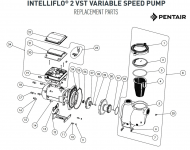I have a Pentair VSF pump. When we first opened the pool, I wrote down the flow rate at various speeds. We have a manual heater bypass valve to isolate flow away from the heater when not in use.
Other than a dirty cartridge filter (which I've already cleaned in hopes of resolving this - no luck); what would cause my pump to have reduced flow (GPM) at a given speed?
Here is some data I logged from my pool. All measurements taken reflect the heater bypassed.
Attempting to operate at the same GPM, I now require a higher pump speed and more energy consumption.
The pump is not noticeably noisier compared with the prior operation
The only anomaly I recall, perhaps around this time, is that we put our heater into operation. Having waited out the original plaster startup wait period, plus the gas meter upgrade delay with utility. When we initially ran the heater the first time, I recall some white "pasty" substance in the water. In hindsight, I suspect it was some pipe dope on the interior of the heater's plumbing that circulated due to the initial heater operation. It has never happened again since the inaugural session.
The other factor has been the reduced water temperature, going from 80-degree temps to now 60-70 degree temps.
I welcome all advice you can offer and any potential remedies I should pursue. Thanks
Other than a dirty cartridge filter (which I've already cleaned in hopes of resolving this - no luck); what would cause my pump to have reduced flow (GPM) at a given speed?
Here is some data I logged from my pool. All measurements taken reflect the heater bypassed.
| Pump Speed | Initial GPM | Initial KW | Current GPM | Current KW |
| 1050 | 26 | 86 | 21 | 81 |
| 1750 | 47 | 354 | 41 | 332 |
| 2500 | 73 | 1007 | 59.5 | 915 |
| 3450 | 96 | 2510 | 82 | 2298 |
Attempting to operate at the same GPM, I now require a higher pump speed and more energy consumption.
| Target GPM | Current Pump speed | Current KW |
| 26 | 1155 | 103 |
| 47 | 1955 | 456 |
| 73 | 3050 | 1616 |
The pump is not noticeably noisier compared with the prior operation
The only anomaly I recall, perhaps around this time, is that we put our heater into operation. Having waited out the original plaster startup wait period, plus the gas meter upgrade delay with utility. When we initially ran the heater the first time, I recall some white "pasty" substance in the water. In hindsight, I suspect it was some pipe dope on the interior of the heater's plumbing that circulated due to the initial heater operation. It has never happened again since the inaugural session.
The other factor has been the reduced water temperature, going from 80-degree temps to now 60-70 degree temps.
I welcome all advice you can offer and any potential remedies I should pursue. Thanks



